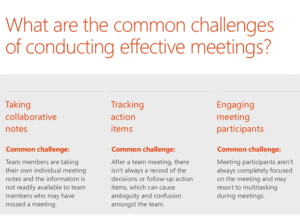Achieving a successful Project Online/Server deployment would require focusing on driving adoption and making sure everyone understands the benefits of working with the new solution. Driving adoption is about understanding the business challenges that will be addressed with the new solution and ensuring the benefits are embraced by your organization. There are four key steps to a successful adoption strategy:
• Establish a vision and create business scenarios
• Prioritize features and create adoption plan
• Assign resources and deploy the adoption plan
• Measure success and share results

Establish a vision and create business scenarios
Setting the business vision for your adoption is critical for success. The vision should list the targeted business objectives and serve as the guild post for your team as you progress through planning and deployment. The vision will also help with securing buy-in throughout the organization.
When setting the vision, be sure to include and involve your stakeholders. This means you must understand who your stakeholders are, what are their business scenarios and own challenges.
You may have to choose several individuals from multiple departments depending on the size of your organization. Don’t be afraid to identify more stakeholders than you think you will need. All these stakeholders can be maintained in the Stakeholder Register with relevant details.
Setting the vision statement requires asking several questions during a vision workshop and then deriving the idea from the answers to these issues. Here are a few:
1. What are our current portfolio management and collaboration challenges?
2. Why are we making this organizational change now?
3. How does a change support our overarching vision and strategy?
4. How does a change in how we work, change the organization?
5. What does success look like?
6. How will a more open way of working help the organization?
7. How will a more open way of working help the employees?
Again, you will want to run several workshops, inviting those stakeholders who will be driving and supporting the change, and ask several questions

Create your set of business scenarios including the current challenges that affected stakeholders and departments.
Prioritize features and create adoption plan
Once you set the vision and business situations, you will need to determine the solution for each of the business scenario challenge is your next step. This may require describing the solution before identifying the solution. To do this, put the solution regarding the user, or user story:
As a , I want to , so I can .
From the list of user stories, you can identify the features within your solution. Also, determine the features which are hurdles or resistance to the adoption plan. Create a solution to the high-friction functions that reduce resistance either through automation or overpowering value.
Prioritize your features based on the features complexity, impact and value to the organization. You can do this using a scoring (1-5 or H/M/L) system or regarding the stakeholder’s requirements (Need, Want, OK).
While establishing your solution and prioritization, it is an excellent time also to identify the success criteria to measure the impact of your deployment. Establish success criteria using the SMART mnemonic (Specific, Measurable, Attainable, Relevant and Timely). Think about how you will collect both quantitative and qualitative data.

To start and baseline your measure, find out what they are currently. Document your success criteria using OneNote with a section for your success criteria including the Description, Source, Metrics, and Goal.
An essential ingredient for a successful adoption plan is to create a champion or Ninja program. The program will be filled with your peers who are passionate about Project Online and can evangelize to the organization to learn more about the solution. This will also take some of the stress off the core project team, discover new opportunities to innovate and provide feedback. Start with those who are enthusiastic who can commit a little time and effort and create an individual Yammer group. By providing them with a little extra training and support, they will be able to run their brown bag sessions. Establish a regular rhythm with your champions/ninjas to foster engagement to learn more about what is working and what is not. Don’t forget to provide them with recognition and praise. You can do this through badges they can use on their email signature line or special privileges.
The adoption plan should also contain a mix of activities to maximize impact and approval. Activities include enterprise announcements or newsletters, engagement events, and training. Announcements and Newsletters are great for creating a buzz within the organization. Engagement events are a perfect place to create a party-like atmosphere where you can further motivate and encourage with contests, giveaways, and recognition. Training is essential to ensuring that employees know how to use Project Online/Server to get their work done.
Assign resources and deploy the adoption plan
It is time to put it all together and put your planning into action. Assign the key resources and begin to implement your adoption plan. Continue to bring awareness of roll out activities to the organization through posters, booklets, countdown/announcement emails, and tips and tricks email. Start these at least 4 to 8 weeks before launch and keep them short and sweet. Have a clear call to action links for more information. Don’t be afraid to address a commonly asked question or enable two-way communications using Yammer or Groups.
Schedule the engagement events and community activities 4 weeks before launch. Invite champions/ninjas to small open sessions to show off their favorite feature and answer question. Conduct lunch and learn sessions on a regular rhythm and encourage attendance with incentives.
Training and support will continue beyond launch. Help the users understand why the organization is using the new solution and show how they will benefit from Project Online/Server. Incorporate a learning center full of training guides, videos, tips, and tricks. Don’t forget the engage your champions/ninjas to help users learn the innovative benefits of Project Online/Server to getting work done.
Measure success and share results
The final step of your deployment is to measure, learn lessons, share results and find opportunities for innovation. Measure progress against your benchmarks and keep user feedback and success stories on a team site.
Use surveys to collect quantitative and qualitative data from users. To make the most out of your survey, circulate a survey shortly before deployment as your baseline. Soon after the deployment, release another study to gain insights about user’s experiences and adjust your plan. 10-12 Weeks after implementation, send a final survey to assess user satisfaction. Send out quarterly surveys to measure adoption.
Driving adoption is a continuous cycle and doesn’t end after deployment. Continue innovation and adding business value by iterating with new learnings. Provide additional training on best practices and conduct business scenario and solution workshops with new departments. Your business is in constant motion and seeks opportunities to improve business processes and empower people.

In this blog, we talked about the 4 steps briefly and we are sure you are interested in knowing every step in detail with practical tips and best practices.To learn more about how to make your Project Server/Online investment a success with faster and increased adoption across the organization, watch the webinar recording “Project Online/Server Adoption Strategy”.



